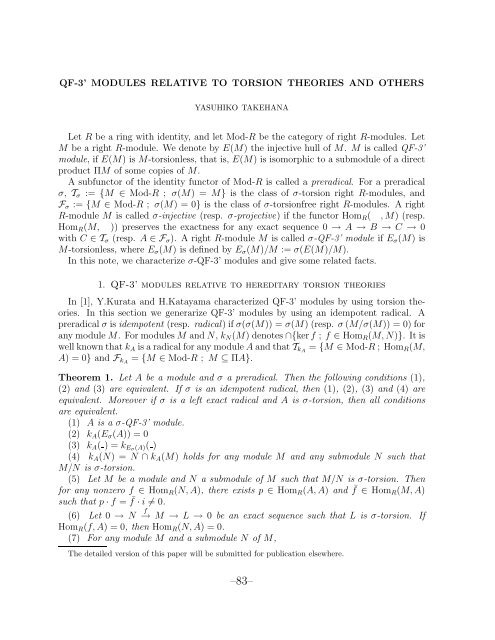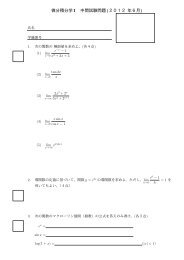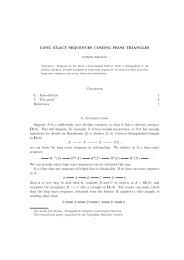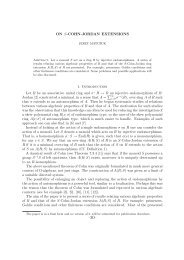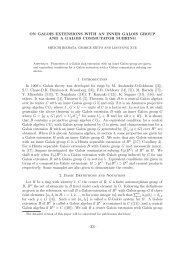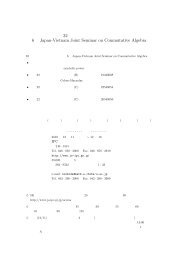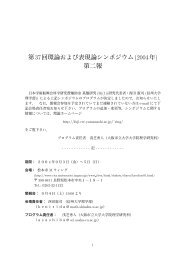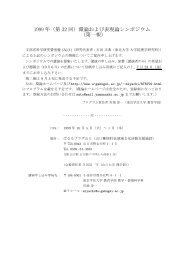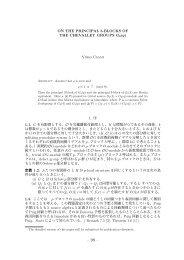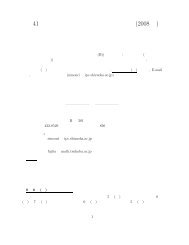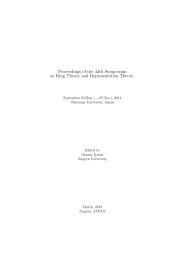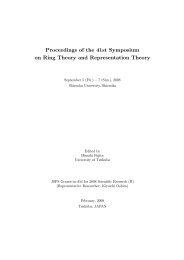Yasuhiko Takehana - FUJI
Yasuhiko Takehana - FUJI
Yasuhiko Takehana - FUJI
Create successful ePaper yourself
Turn your PDF publications into a flip-book with our unique Google optimized e-Paper software.
QF-3’ MODULES RELATIVE TO TORSION THEORIES AND OTHERS<br />
YASUHIKO TAKEHANA<br />
Let R be a ring with identity, and let Mod-R be the category of right R-modules. Let<br />
M be a right R-module. We denote by E(M) the injective hull of M. M is called QF-3’<br />
module, ifE(M) isM-torsionless, that is, E(M) is isomorphic to a submodule of a direct<br />
product ΠM of some copies of M.<br />
A subfunctor of the identity functor of Mod-R is called a preradical. For a preradical<br />
σ, T σ := {M ∈ Mod-R ; σ(M) =M} is the class of σ-torsion right R-modules, and<br />
F σ := {M ∈ Mod-R ; σ(M) =0} is the class of σ-torsionfree right R-modules. A right<br />
R-module M is called σ-injective (resp. σ-projective) if the functor Hom R ( ,M) (resp.<br />
Hom R (M, )) preserves the exactness for any exact sequence 0 → A → B → C → 0<br />
with C ∈T σ (resp. A ∈F σ ). A right R-module M is called σ-QF-3’ module if E σ (M) is<br />
M-torsionless, where E σ (M) is defined by E σ (M)/M := σ(E(M)/M).<br />
In this note, we characterize σ-QF-3’ modules and give some related facts.<br />
1. QF-3’ modules relative to hereditary torsion theories<br />
In [1], Y.Kurata and H.Katayama characterized QF-3’ modules by using torsion theories.<br />
In this section we generarize QF-3’ modules by using an idempotent radical. A<br />
preradical σ is idempotent (resp. radical)ifσ(σ(M)) = σ(M) (resp. σ (M/σ(M)) = 0) for<br />
any module M. For modules M and N, k N (M) denotes ∩{ker f ; f ∈ Hom R (M,N)}. Itis<br />
well known that k A is a radical for any module A and that T kA = {M ∈ Mod-R ; Hom R (M,<br />
A) =0} and F kA = {M ∈ Mod-R ; M ⊆ ΠA}.<br />
Theorem 1. Let A be a module and σ a preradical. Then the following conditions (1),<br />
(2) and (3) are equivalent. If σ is an idempotent radical, then (1), (2), (3) and (4) are<br />
equivalent. Moreover if σ is a left exact radical and A is σ-torsion, then all conditions<br />
are equivalent.<br />
(1) A is a σ-QF-3’ module.<br />
(2) k A (E σ (A)) = 0<br />
(3) k A ( )=k Eσ(A)( )<br />
(4) k A (N) =N ∩ k A (M) holds for any module M and any submodule N such that<br />
M/N is σ-torsion.<br />
(5) Let M be a module and N a submodule of M such that M/N is σ-torsion. Then<br />
for any nonzero f ∈ Hom R (N,A), there exists p ∈ Hom R (A, A) and ¯f ∈ Hom R (M,A)<br />
such that p · f = ¯f · i ≠0.<br />
(6) Let 0 → N → f M → L → 0 be an exact sequence such that L is σ-torsion. If<br />
Hom R (f,A) =0, then Hom R (N,A) =0.<br />
(7) For any module M and a submodule N of M,<br />
The detailed version of this paper will be submitted for publication elsewhere.<br />
–83–
(i) If M ∈T kA and M/N ∈T σ , then N ∈T kA .<br />
(ii) If N ∈F kA and M/N ∈F kA ∩T σ , then M ∈F kA .<br />
(8) If M ∈F kA , then E σ (M) ∈F kA .<br />
(9) If N is an essential submodule of a module M such that M/N ∈T σ and N ∈F kA ,<br />
then M ∈F kA .<br />
As an application of Theorem 1, we give a characterization of the ring having the<br />
property that a right maximal quotient ring Q is torsionless.<br />
Corollary 2. Let Q be a maximal right quotient ring of R. Then the following conditions<br />
are equivalent.<br />
(1) Q is torsionless (i.e., Q ⊂ ΠR).<br />
(2) k R (Q) =0<br />
(3) k R ( )=k Q ( )<br />
(4) k R (N) =N ∩ k R (M) holds for a module M and any submodule N of M such that<br />
Hom R (M/N,E(R)) = 0.<br />
Proposition 3. If σ is a left exact radical, (7) of (i) is equivalent to the condition (10)<br />
T kA = T kEσ(A) .<br />
For a module M, Z(M) denote the singular submodule of M, that is ,Z(M) :={m ∈<br />
M ; (0 : m) is essential in R}, where (0 : m) ={r ∈ R ; mr =0}.<br />
Proposition 4. If σ is a left exact radical and A ∈T σ ∩F Z , then (7) of (i) is equivalent<br />
to the condition (1), that is, E σ (A) ⊆ ΠA is equivalent to the condition that T kA is closed<br />
under taking σ-dense submodules.<br />
A module N is called a σ-essential extension of M if N is an essential submodule of M<br />
such that M/N is σ-torsion.<br />
Lemma 5. Let σ be an idempotent radical and M a σ-essential extension of a module<br />
N. Then E σ (M) =E σ (N) holds.<br />
Proposition 6. Let σ be an idempotent radical. Then the class of σ-QF-3’ modules is<br />
closed under taking σ-essential extensions.<br />
2. σ-left exact preradicals and σ-hereditary torsion theories<br />
A preradical t is left exact if t(N) = N ∩ t(M) holds for any module M and any<br />
submodule N of M. In this section we generalize left exact preradicals by using torsion<br />
theories.<br />
Let σ be a preradical. We call a preradical t σ-left exact if t(N) =N ∩ t(M) holds for<br />
any module M and any submodule N of M with M/N ∈T σ . If a module A is σ-QF-3’<br />
and t = k A , then t is a σ-left exact radical. Now we characterize σ-left exact preradicals.<br />
Lemma 7. For a preradical t and σ, let t σ (M) denote M ∩ t(E σ (M)) for any module M.<br />
Then t σ (M) is uniquely determined for any choice of E(M).<br />
Lemma 8. Let t be a preradical and σ an idempotent radical. Then t σ is a σ-left exact<br />
preradical.<br />
–84–
Theorem 9. Let σ be an idempotent radical. We consider the following conditions on a<br />
preradical t. Then the implications (5) ← (1) ⇔ (2) → (3) ⇔ (4) hold. If t is a radical,<br />
then (4) → (1) holds. If t is an idempotent preradical and σ is left exact, then (5)(i) → (1)<br />
holds. Thus if t is an idempotent radical and σ is a left exact radical, then all conditions<br />
are equivalent.<br />
(1) t is a σ-left exact preradical.<br />
(2) t(M) =M ∩ t(E σ (M)) holds for any module M.<br />
(3) F t is closed under taking σ-essential extension, that is, if M is an essential extension<br />
of a module N ∈F t with M/N ∈T σ , then M ∈F t .<br />
(4) F t is closed under taking σ-injective hulls, that is, if M ∈F t , then E σ (M) ∈F t .<br />
(5) For any module M and a submodule N of M,<br />
(i) T t is closed under taking σ-dense submodules, that is, if M ∈T t and M/N ∈T σ ,<br />
then N ∈T t .<br />
(ii) F t is closed under taking σ-extensions, that is, if N ∈F t and M/N ∈F t ∩T σ ,<br />
then M ∈F t .<br />
A torsion theory for Mod-R is a pair (T , F) of classes of objects of Mod-R satisfying<br />
the following three conditions.<br />
(i) Hom R (T,F) = 0 for all T ∈T and F ∈F.<br />
(ii) If Hom R (M,F) = 0 for all F ∈F, then M ∈T.<br />
(iii) If Hom R (T,N) = 0 for all T ∈T, then N ∈F.<br />
We put t(M) = ∑ N (= ∩N ), then T = T t and F = F t hold.<br />
M/N∈F<br />
T∋N⊂M<br />
For a torsion theory (T , F), if T is closed under taking submodules, then (T , F) is<br />
called a hereditary torsion theory. T is closed under taking submodules if and only if F<br />
is closed under taking injective hulls.<br />
Now we call (T , F) aσ-hereditary torsion theory if T is closed under taking σ-dense<br />
submodules. If σ is a left exact radical, T is closed under taking σ-dense submodules if<br />
and only if F is closed under taking σ-injective hulls by Theorem 9.<br />
Proposition 10. Let t be an idempotent preradical and σ a radical such that F σ is<br />
included F t .IfF t is closed under taking σ-injective hulls, then F t is closed under taking<br />
injective hulls.<br />
Thus if σ is a left exact radical, T σ ⊇T t and (T t , F t )isaσ-hereditary torsion theory,<br />
then (T t , F t ) is a hereditary torsion theory.<br />
Proposition 11. If σ(M) contains the singlar submodule Z(M) for any module M, then<br />
a σ-left exact preradical is a left exact preradical.<br />
Theorem 12. Let σ be a left exact radical. Then (T , F) is σ-hereditary if and only if there<br />
exists a σ-injective (σ-QF-3’) module Q such that T = {M ∈ Mod-R ; Hom R (M,Q) =<br />
0}.<br />
Proposition 13. Let σ be an idempotent radical and (T , F) a σ-hereditary torsion theory,<br />
where T = {M ∈ Mod-R ; Hom R (M,Q) =0} for some σ QF-3’ module Q in F. Let M<br />
be a σ-torsion module. Then M is in F if and only if M is contained in a direct product<br />
of some copies of Q.<br />
–85–
3. CQF-3’ modules relative to torsion theories<br />
A preradical t is called epi-preserving if t(M/N) =(t(M)+N)/N for any module M<br />
and any submodule N of M. A short exact sequence 0 → K(M) → P (M) → M → 0 is<br />
a projective cover of a module M if P (M) is projective and K(M) is small in P (M).<br />
In [2], F.F. Mbuntum and K. Varadarajan dualized QF-3’ modules and characterized<br />
them. Let M be a module with a projective cover. M is called a CQF-3’ module if P (M)<br />
is M-generated, that is, P (M) is isomorphic to a homomorphic image of a direct sum<br />
⊕M of some copies of M. In this section we generalize CQF-3’ modules and characterize<br />
them.<br />
A short exact sequence 0 → K σ (M) → P σ (M) → M → 0 is called σ-projective cover of<br />
a module M if P σ (M) isσ-projective and K σ (M) isσ-torsion and small in P σ (M). If σ is<br />
an idempotent radical and a module M has a projective cover, then M has a σ-projective<br />
cover and it is given K σ (M) =k(M)/σ(K(M)),P σ (M) =P (M)/σ(K(M)). Now we call<br />
a module M with a projective cover a σ-CQF-3’module if P σ (M) isM-generated. Let<br />
t M (N) denote the sums of images of all homomorphisms from M to N for a module M<br />
and a module N.It is well known that t A is an idempotent preradical for any module A<br />
and T tA = {M ∈ Mod-R ; ⊕A → M → 0} and F tA = {M ∈ Mod-R ; Hom(A, M) =0}.<br />
Theorem 14. Let σ be a preradical, and suppose that a module A has a σ-projective<br />
cover 0 → K σ (A) → P σ (A) → A → 0. Consider the following conditions.<br />
(1) P σ (A) is a σ-CQF-3’ module.<br />
(2) t A (P σ (A)) = P σ (A)<br />
(3) t A ( )=t Pσ(A)( )<br />
(4) t A ( ) is a σ-epi-preserving preradical, that is, t A (M/N) =(t A (M) +N)/N holds<br />
for any module M and any submodule N ∈F σ .<br />
(5) (i) T tA is closed under taking F σ -extensions, that is, t A (M) =M holds for any<br />
module M and any submodule N of M such that M/N ∈T tA and N ∈F σ ∩T tA .<br />
(ii) F tA is closed under taking F σ -factor modules, that is, M/N ∈F tA holds for any<br />
module M ∈F tA and any submodule N ∈F σ of M.<br />
(6) T tA is closed under taking σ-projective covers, that is, P σ (M) ∈T tA holds for any<br />
module M ∈T tA .<br />
(7) T tA is closed under taking σ-coessential extensions, that is, for any module M if<br />
there exists a small submodule N in F σ such that M/N ∈T tA then M is in T tA .<br />
(8) If Hom R (A, f) =0, then Hom R (A, M/N) =0holds for any module M and any<br />
submodule N ∈F σ .<br />
Then (1) → (2) → (3) → (1) and (4) → (1) hold. If σ is idempotent, then (3) → (4),<br />
(1) → (8) and (6) → (5), (7) hold. If σ is a radical, then (7) → (6), (4) → (2), (6) hold.<br />
If σ is an epi-preserving radical and A is in F σ , then (8) → (5) holds, moreover if σ is<br />
idempotent then (5) → (2) holds.<br />
Thus if σ is an epi-preserving idempotent radical and A is in F σ , all conditions are<br />
equivalent.<br />
Proposition 15. Let σ be an epi-preserving idempotent radical. Then the following<br />
conditions on a module A are equivalent.<br />
–86–
(1) F tA is closed under taking F σ -factor modules.<br />
(2) F tA = F tPσ(A)<br />
Lemma 16. Let σ be an idempotent radical. If N is in F σ and is a small submodule of<br />
M, then P σ (M/N) ∼ = P σ (M) holds.<br />
Proposition 17. Let σ be an idempotent radical. The class of σ CQF-3’ modules is<br />
closed under taking σ-coessntial extensions, that is, if a module M has a small submodule<br />
N ∈F σ such that M/N is a σ-CQF-3’ module, then M is also a σ-CQF-3’ module.<br />
4. σ-epi-preserving preradicals and σ-cohereditary torsion theories<br />
In this section we characterize σ-epi-preserving preradicals when R is a right perfect<br />
ring.<br />
Theorem 18. Let R be a right perfect ring and σ an idempotent radical. Consider the<br />
following conditions on a preradical t.<br />
(1) t is an σ-epi-preserving preradical, that is, t(M/N) =(t(M) +N)/N holds for a<br />
module M and any submodule N ∈F σ of M.<br />
(2) T t is closed under taking σ-coessential extensions, that is, for any module M if<br />
there exists a small submodule N in F σ such that M/N ∈T t then M is in T t .<br />
(3) T t is closed under taking σ-projective covers, that is, P σ (M) ∈T t holds for any<br />
module M ∈T t .<br />
(4) (i) F t is closed under taking F σ -factor modules, that is, M/N ∈F t holds for any<br />
module M ∈F t and any submodule N ∈F σ of M.<br />
(ii) T t is closed under taking F σ -extensions, that is, t(M) =M holds for any module<br />
M and any submodule N of M such that M/N ∈T t and N ∈F σ ∩T t .<br />
Then (4) ← (1) → (2) ⇔ (3) hold. If t is an idempotent preradical,then (3) → (1) holds.<br />
If σ is an epi-preserving preradical and t is a radical, then (4) → (1) holds. Thus if σ is<br />
an epi-preserving idempotent radical and t is an idempotent radical, then all conditions<br />
are equivalent.<br />
We call a torsion theory (T , F) σ-cohereditary torsion theory if F is cosed under taking<br />
F σ -factor modules for an idempotent radical σ.<br />
Theorem 19. Let R be a right perfect ring and σ an epi-preserving idempotent radical.<br />
Then a torsion theory (T , F) is σ-cohereditary if and only if there exists an σ-projective<br />
(σ-CQF-3’) module Q such that F = {M ∈ Mod-R ; Hom R (Q, M) =0}.<br />
Proposition 20. Let R be a right perfect ring, σ be an idempotent radical and (T , F) be<br />
a σ-cohereditary torsion theory, where F = {M ∈ Mod-R ; Hom R (Q, M) =0} for some<br />
σ-CQF-3’ module Q ∈T. Let M be a σ-torsionfree module. Then M ∈T if and only if<br />
M is generated by Q.<br />
5. σ-stable torsion theory and σ-costable torsion theory<br />
A torsion theory (T t , F t ) is called stable if T t is closed under taking injective hulls. In<br />
this section we generalize stable torsion theory by using torsion theories.<br />
–87–
Proposition 21. Let σ be an idempotent radical and L a submodule of a module M.<br />
Then the implications (1) → (2) → (3) hold. Moreover, if σ is a left exact radical, then<br />
(3) → (1) holds.<br />
(1) L is σ-complemented in M, that is, there exists a submodule K of M such that L<br />
is maximal in Γ K = {L i ; L i ⊆ M,L i ∩ K =0,M/(L i + K) ∈T σ }<br />
(2) L = E σ (L) ∩ M.<br />
(3) L is σ-essentially closed in M,that is, there is no σ-essential extension of L in M.<br />
We call a preradical tσ-stable if T t is closed under taking σ-injective hulls. We put<br />
X t (M) :={X ; M/X ∈T t } and N ∩X t (M) :={N ∩ X ; X ∈X t (M)}.<br />
Theorem 22. Let t be an idempotent preradical and σ an idempotent radical. Then the<br />
following conditions (1), (2) and (3) are equivalent. Moreover, if σ is left exact and T t is<br />
closed under taking σ-dense submodules, then all the following conditions are equivalent.<br />
(1) t is σ-stable, that is, T t is closed under taking σ-injective hulls.<br />
(2) The class of σ-injective modules are closed under taking the unique maximal t-<br />
torsion submodules, that is, t(M) is σ-injective for any σ-injective module M.<br />
(3) E σ (t(M)) ⊂ t(E σ (M)) holds for any module M.<br />
(4) T t is closed under taking σ-essential extensions.<br />
(5) If M/N is σ-torsion, then N ∩X t (M) =X t (N) holds.<br />
(6) For any module M, t(M) is σ-complemented in M.<br />
(7) For any module M, t(M) =E σ (t(M)) ∩ M holds.<br />
(8) For any module M, t(M) is σ-essentially closed in M.<br />
(9) For any σ-injective module E with E/t(E) ∈T σ , t(E) is a direct summand of E.<br />
(10) E σ (t(M)) = t(E σ (M)) holds for any module M.<br />
If T t is closed under taking σ-dense submodules, then (1) → (4) → (5) hold. Moreover,<br />
if σ is left exact, then (1) → (6) and (3) → (10) hold.<br />
It is well known that if R is right noetherian, t is stable if and only if every indecomposable<br />
injective module is t-torsion or t-torsionfree. By using Theorem 1 in [3], we<br />
generalized this as follows.<br />
Theorem 23. Let t be an idempotent radical and σ a left exact radical. Then<br />
(1) If t is σ-stable, then (∗) every indecomposable σ-injective module E with E/T(E) ∈<br />
T σ is either t-torsion or t-torsionfree.<br />
(2) If the ring R satisfies the condition (∗) and the ascending chain conditions on<br />
σ-dense ideals of R, then T t ∩T σ is closed under taking σ-injective hulls.<br />
We now dualize σ-stable torsion theory. Let R be a right perfect ring. We call a<br />
preradical tσ-costable if F t is closed under taking σ-projective covers.<br />
Theorem 24. Let σ be an idempotent radical. Then a radical t is σ-costable if and only<br />
if the class of σ-projective modules is closed under taking the unique maximal t-torsionfree<br />
factor modules, that is, P/t(P ) is σ-projective for any σ-projective module P .<br />
6. σ-singular submodules<br />
Let σ be a left exact radical. For a module M we put Z σ (M) :={m ∈ M ; (0 : m) is<br />
σ-essential in R} and call it σ-singular submodule of M. Since R/(0 : m) ∈T Z ∩T σ , then<br />
–88–
Z σ (M) ⊆ Z(M) ∩ σ(M) =Z(σ(M)) = σ(Z(M)), and so Z σ (M) ={m ∈ M ; mR ∈<br />
T Z ∩T σ }. Since Z and σ is left exact, Z σ is also left exact. We will call Mσ-singular<br />
(resp. σ-nonsingular) ifZ σ (M) =M (resp. Z σ (M) = 0).<br />
Proposition 25. Let σ be an idempotent radical and E a σ-nonsingular module and T =<br />
{M ∈ Mod-R ; Hom R (M,E) =0}. Then T is closed under taking σ-essential extensions.<br />
Therefore a torsion theory (T , F) is σ-stable, where F = {M ∈ Mod-R ; Hom R (X, M) =<br />
0 for any X ∈T}.<br />
Proposition 26. Let σ a left exact radical. Then the following facts hold.<br />
(1) If N is σ-essential in M, then Z σ (M/N) =M/N.<br />
(2) A right ideal of R is σ-essential in R if and only if Z σ (R/I) =R/I.<br />
(3) Let M be a σ-nonsingular module and N a submodule of M. Then N is σ-essential<br />
in M if and only if Z σ (M/N) =M/N.<br />
(4) For a module M, Z σ (M/Z σ (M)) = M/Z σ (M) holds if and only if Z σ (M) is σ-<br />
essential in M.<br />
(5) For a simple right R-module S, S is σ-nonsingular if and only if S is σ-torsionfree<br />
or projective.<br />
(6) If R is σ-nonsingular, then Z σ is left exact radical.<br />
(7) If M/N is σ-nonsingular for a module M and a submodule N of M, then N is<br />
σ-complemented in M. IfM is σ-nonsingular, then the converse holds.<br />
7. σ-small and σ-radical<br />
Let σ be a left exact radical. A submodule N of a module M is called σ-dense in M if<br />
M/N is σ-torsion. A module M is called σ-cocritical if M is σ-torsionfree and L is σ-dense<br />
in M for any nonzero submodule L of M. It is well known that nonzero submodule of<br />
σ-cocritical module M is essential in M. A module M is called σ-noetherian if for every<br />
ascending chain I 1 ⊆ I 2 ⊆ I 3 ⊆ I 4 ⊆ ······ ⊆ M, (where ∪I j is σ-dense in M), there<br />
exists a positive integer k such that I k is σ-dense in M. Let J σ (M) denote ∩N i (M/N i is<br />
σ-cocritical).<br />
Now we define σ-small submodule as follows. A submodule N of a module M is called<br />
σ-small in M if M/(N + X) ∈T σ implies M/X ∈T σ for any submodule X of M.<br />
Theorem 27. J σ (M) contains ∑ N(N is σ-small in M). Conversely if M be a σ-<br />
noetherian module, then J σ (M) coincides with ∑ N(N is σ-small in M).<br />
Remark 28. We can see in [4] that the definition of σ-small is different from ours.<br />
(B.A.Benander’s definition). N is σ-small in M if M/(N ′ + X) ∈T σ and M/X ∈F σ ,<br />
then M = X for any X of M, where σ(M/N) =N ′ /N.<br />
Benander’s definition of σ-small is a stronger condition than ours.<br />
In fact, if M/(N + X) ∈T σ , then M/(N ′ + X) ∈T σ . We put X ′ /X := σ(M/X).<br />
Then M/X ′ ∈F σ . Since M/(N ′ + X) ∈T σ , M/(N ′ + X ′ ) ∈T σ . Thus M = X ′ , and so<br />
M/X ∈T σ , as desired.<br />
References<br />
[1] Y.Kurata and H.Katayama, On a generalizations of QF-3’rings, Osaka J. Math.,13(1976),407-418.<br />
[2] F.F.Mbuntum and K.Varadarajan, Half exact preradicals, Comm. in Algebra, 5 (1977), 555-590.<br />
–89–
[3] K.Masaike and T.Horigome, Direct sums of σ-injective modules, Tsukuba J. Math., Vol 4(1980) 77-81.<br />
[4] B.A.Benander, Torsion theory and modules of finite length, PhD.thesis, Kent State University, 1980.<br />
General Education<br />
Hakodate National College of Technology,<br />
14-1 Tokura-cho Hakodate Hokkaido, 042-8501 Japan<br />
E-mail address: takehana@hakodate-ct.ac.jp<br />
–90–


